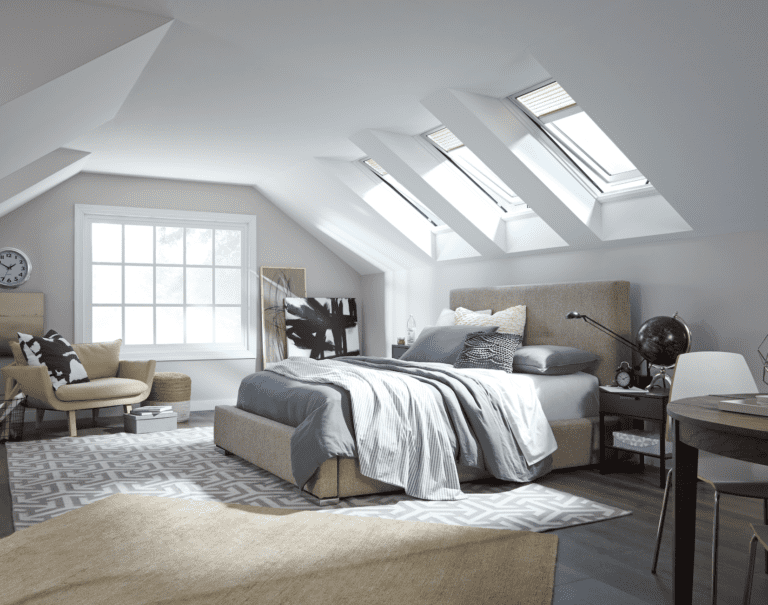
Skylight Installation in Pittsburgh: What You Should Know
Leaving your cozy bed in the morning is made so much harder when the temperatures outside reach their winter chill. Whether is waking yourself up with a morning shower, or a steaming cup of coffee, skylights are a great option to brighten up your morning routine with natural light provided by a skylight.
What Are The Benefits of Installing a Skylight?
Natural Lighting
A big reason most people choose to incorporate a skylight(s) into their home is for the boost in natural lighting. A skylight can offer a significant amount of natural light into your home, as they provide consistent light all day long, rather than a window’s light which is limited to its orientation to the sun during a given time of day.
Increased Home Value
Skylights have become more and more popular over the last few decades. House hunters are more likely to purchase a home that already includes skylights, rather than installing them themselves later.
More Space
Skylights can provide the perfect amount of light to open up a room and create the illusion that it is much larger than its square footage. Skylights also offer more wall space for décor, shelving, furniture, etc., as they live on the ceiling.
Ventilation
Depending on the model, skylights can offer added ventilation to a home. There are skylights with manual, electric and solar mechanisms to open them. This feature works great for rooms that lack ventilation, such as a bathroom.
Health Benefits
Skylights offer much more sunlight to enter a home than standard windows. This natural sunlight provides a boost in Vitamin D. In addition, natural sunlight is an active combatant of Season Affective Disorder (seasonal depression), a disorder commonly caused by gray skies and lack of sunlight.
Can I Add Skylights to My Existing Roof?
There are a few things that help determine if your roof is a good candidate to add sky lighting. First and foremost, it is important to determine if a skylight will compromise the integrity of your roof. Other things such as the slope of the roof and type of roofing shingles also play a role in this decision. These factors contribute to leak protection. In addition to these key elements, the direction your home faces will contribute to the amount of natural light the sky light brings into your home.
Where Should I Put My Skylight?
It is important to consider building codes in relation to slope, distance apart if you have multiple, and other depending on your location. These things can contribute to your decision on skylight location.
The best location for a sky light is determined by how much natural light you are seeking to bring into your home. For example, east facing skylights bring in the most light in the mornings, while west facing skylights bring in afternoon and evening light. Another consideration when determining where you want your skylight are outside factors. Will your neighbor’s home block your light? What about a large tree in you or your neighbor’s yard?
DIY vs. Professional Skylight Installation
The installation of a skylight requires a home’s roof to be cut. This task alone can make or break the installation. While this may seem like a small feat, it is best to trust a professional with this installation. A skylight requires weatherproofing to last for years to come. Once over this hump, building and insulating the space between a ceiling and roof, known as the light well.
What Are The Types of Skylights
Now that you know where you want your skylight, what kind do you want?
- Fixed Skylights
Fixed skylights are unable to be opened and simply offer added natural light into a home. This style is typically found in higher ceilings that are unable to be reached easily.
- Vented Skylights
Vented skylights offer not only natural light, but ventilation. Vented skylights can have manual, electric, or solar powered openers. This style is great for rooms that experience humidity or condensation, such as kitchens and bathrooms. Some options even offer moisture sensors which close the skylight during inclement weather.
- Tubular Skylights
Tubular skylights are not traditional skylights as they are long tubes that reflect light into a home. The biggest difference between this style and fixed and vented skylights, is that they do not provide a view to the outside. These skylights are also known as solar skylights. This style is commonly found in small spaces such as hallways, closets, and bathrooms. Some tubular skylights include dimmers which allow for the light provided to be controlled. Other common features of tubular skylights include an exhaust fan to control moisture or a filter to eliminate UV light.
Do Skylights Save On Energy?
For those who love natural lighting, skylights can help their household save big on electricity costs. Because skylights offer such a large amount of natural light into a home, it decreases the need for flipping light switches on during the day. Ventilate skylights offer an alternative to having a fan running and allows a natural flow of air in and out of the home.
Citations:
https://www.energy.gov/energysaver/skylights
https://www.iko.com/na/learning-center/roofing-101/introduction-to-roofing-skylights/
https://www.forbes.com/home-improvement/windows/cost-to-install-skylight/
https://thearchitectsdiary.com/top-benefits-of-skylights-for-your-home/
